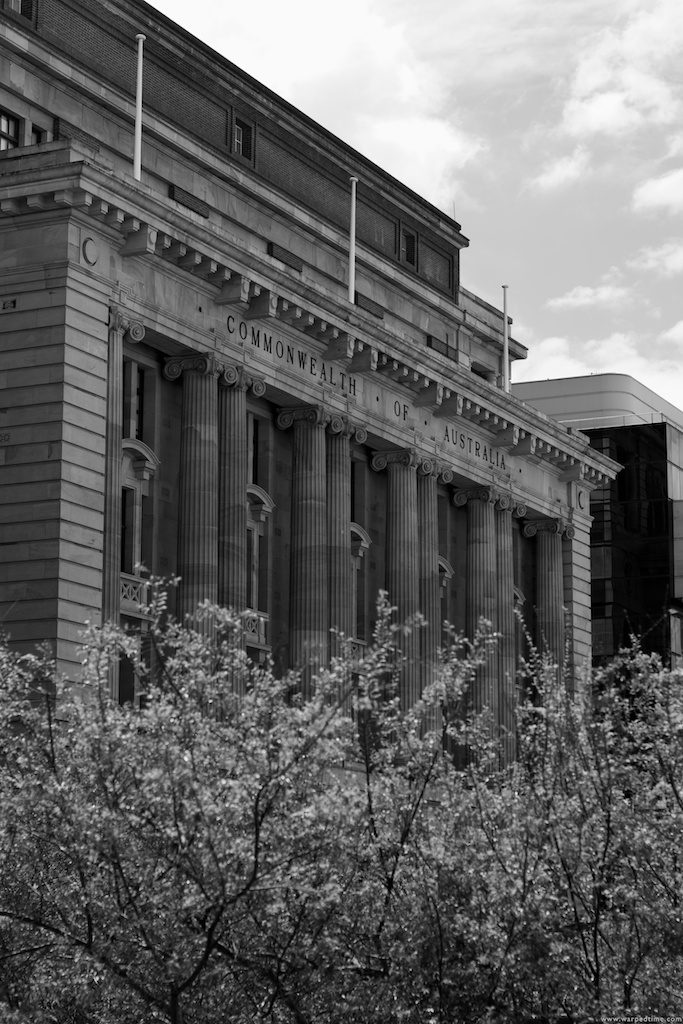
The discovery of gold changed everything in Western Australia.
Family history, Western Australian history, or just history
Capital city of Western Australia located at the intersections of the Swan and Canning rivers. Not to be confused with Perth, capital of Perth-shire, Scotland or Perth, a tiny town in northern Tasmania, OR the one in Canada.

There was nothing particularly unusual about the citizens of Perth suing each other in the civil courts during the 19th Century. It was more out of the ordinary not to be embroiled in some sort of legal action at any given moment. Being able to sh*tpost on social media instead, as a means of passing the time, lay a century or more into the future.
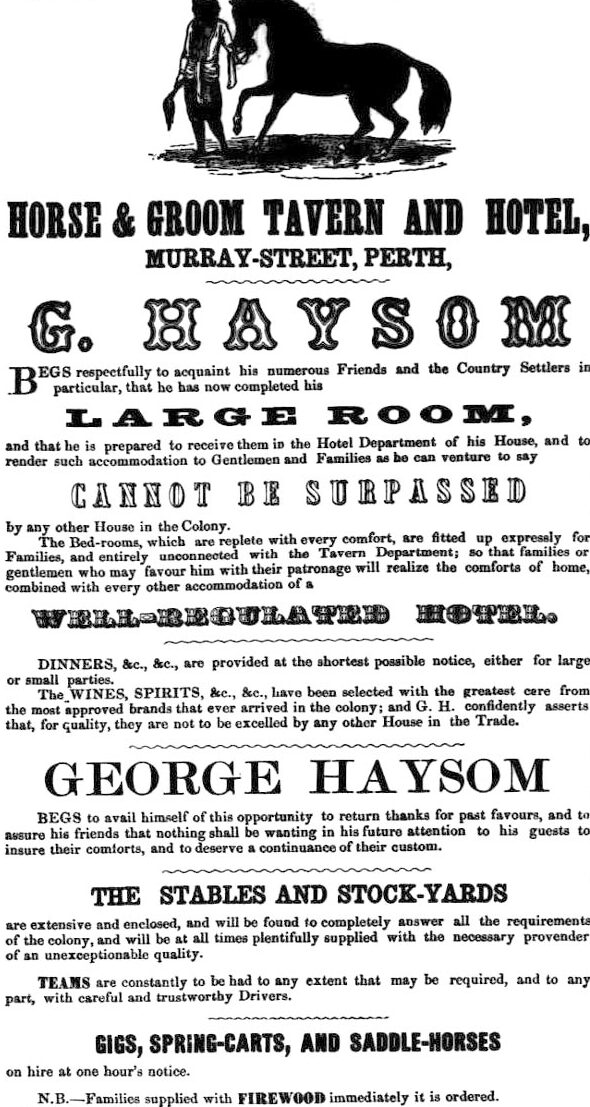
George Haysom (1822 – 1868) was a successful carter, publican, horse-breeder and wheelwright — among his many positive personal attributes. His eternal fame in Western Australian history should be inviolable, for he was the first man ever in Perth to roast a bullock in public AND be the owner of the first ever horse in the colony to die of snake bite (that anyone knew of).

Roasting a bullock: Another rabbit hole to dive down
On Tuesday, 9 May 1854 it was Mr George Haysom’s turn to appear before the Commissioner as a defendant. He was represented this day by lawyer George Frederick Stone. His two prosecutors retained George Walpole Leake to represent them.
Back in January, Haysom hired out one of his horses to this pair of speculators so they could transport some trade goods from Fremantle down to Bunbury. His horse was returned to him a couple of weeks later, but he still awaited a settling of the account, and that was when one of the customers returned to him with a proposition to sell him the cart used for the run — some of the proceeds from the sale would be returned to him to cover what he was owed.
After some intense haggling over the cart’s value, they agreed on the sum of £25. To seal the deal, Haysom produced a bottle of ale (at his own expense) — “to wet the bargain” — That was how he rolled.
Haysom had only been in possession of his new ride a couple of days when he was accosted by the other man who demanded to know why he had possession of “his” cart.
Soon afterwards, the first individual who sold him the cart returned and begged him to let them both have it back. Haysom was fundamentally a decent sort. After a conference in the small parlour of his “Horse & Groom Tavern” with both the partners present this time, he agreed to return the cart if he was repaid his accumulated debt — a sum of £7 11s 2d.
They agreed. Haysom was not paid in cash, but with a promissory note due at six weeks in the future. The following evening he received a letter from Mr George Walpole Leake, the lawyer for one of the partners, demanding damages for the detention and injury of the cart.
[…]what the deuce did you send me such a letter for ?”
… Haysom now wanted to know.
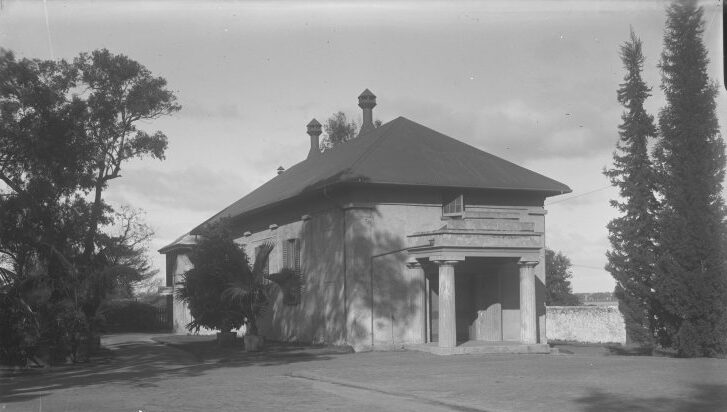
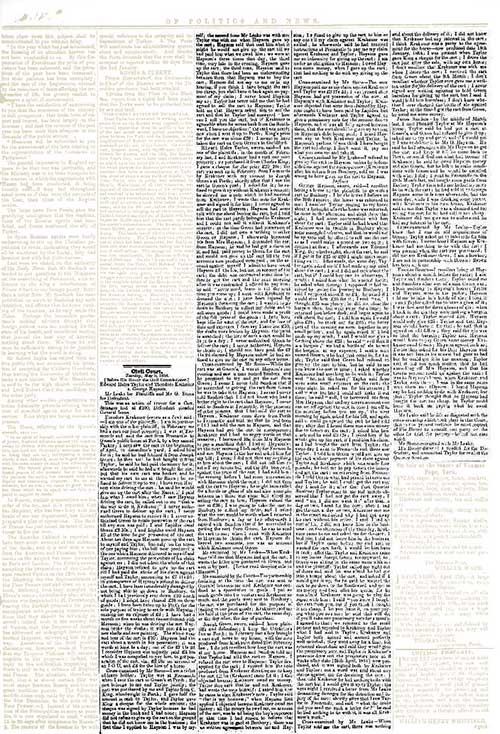
The case was heard in the Old Court House building (the one impossible to take seriously once you have heard someone ask if it is the public toilet block for the Supreme Court gardens). The testimony of all the witnesses, who included Haysom and both his prosecutors, were presented in excruciating detail three day later in one of the local papers.
All that really needs to be explained is that one of the prosecutors had sold their cart to Haysom without consulting his co-owner beforehand.
The verdict was duly delivered in Haysom’s favour — as it should have been. None of this would be remotely interesting were it not for the summing up of the prosecutor’s legal representative after the last witness had delivered his testimony and was thoroughly cross-examined over it. Remember, Leake was being paid to advocate on behalf of the plaintiffs in this case…
Mr Leake said he felt so disgusted with the cross-swearing which took place in that Court, that in the present instance he must request of His Honor to commit one party or the other for trial for perjury —he did not care which.
The Perth Gazette and Independent Journal of Politics and News, 12 May 1854, page 3.
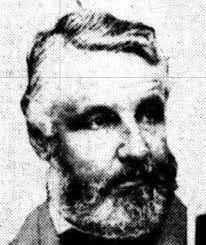
One of his clients was subsequently sent to gaol for perjury.
His eccentric wit and the justice he dispensed was not always conventional”
Says George Walpole Leake’s entry in the Australian Biographical Dictionary.
Indeed!
And here is where this article might ordinarily have concluded.
George Haysom is an important figure in James Dyson’s story, alongside that of the Sons of Australia Benefit Society, and the history of the Perth City Council. — but it is his (carefully unnamed up to now) prosecutors that deserve a bit more attention.
Theodore Krakouer (1818 -1877) was the one who initiated the legal action against Haysom. He was a Western Australian ticket-of-leave convict about who a lot has already been written because he has descendents famous for playing Australian rules football.
He was the wronged party in this court case, however the one who he should have taken to court was not Haysom, but his erstwhile business partner, a shadowy figure by the name of Edward Hale(s) Taylor. It was he who sold the cart they co-owned while his partner was otherwise detained. It was Taylor who was subsequently sentenced to 18 months imprisonment for perjury after the civil trial.
Krakouer deserves to be better known, but as far as I can tell, no one has ever put together all the pieces of Edward Hale(s) Taylor‘s story before. A rough attempt begins next.

During the early 1840s, Western Australia experienced its first modern economic boom. This both contributed to and was fed by a sudden expansion in the white settler population. Between 1837 and 1843 the European population doubled.
While that sounds impressive, consider this: The total population in 1837 was only 2,025 men, women and children. There might have been 60 or 70 additional soldiers, but they were not included in the settlement’s census, neither were the First Nations people living about them.
To put this in a context that the settlers of that day would well understand, during the Napoleonic war fought a generation or so before, ships-of-the-line, the mightiest ships of the day could easily carry a compliment of over one thousand fighting men as crew. Admiral Nelson’s flag ship HMS Victory carried a crew of 821 into the battle of Trafalgar during 1803 (but this is perhaps not the best example as there were considerably fewer of that number left after the battle).
The crew of the L’Orient, French flag ship during the Battle of the Nile (1798) fared even worse, exploding in the heat of the moment. She had a compliment of 1,130, but how many of those died or were even on board at the time is still a debated point.

What point that is attempting to be made is that even after doubling, the entire settler population of Western Australia could have fitted on as little as four of such ships. After the boom ended in 1843 the settler population contracted a little. Serious debate was held around that time about abandoning the colony. I don’t believe that could ever have happened, but if it had happened, this was the last moment it could practically have occurred.
After the 1840’s boom, as it had been before, and as it has remained ever since — over half the colony’s settler population lived in and around the capital city of Perth. The modern entity of Western Australia predominantly was, and always has been, an urban civilisation. This is not a value judgment. It is a historial fact that at times has proved politically inconvenient for our own self image and the reality of how most of us now live.
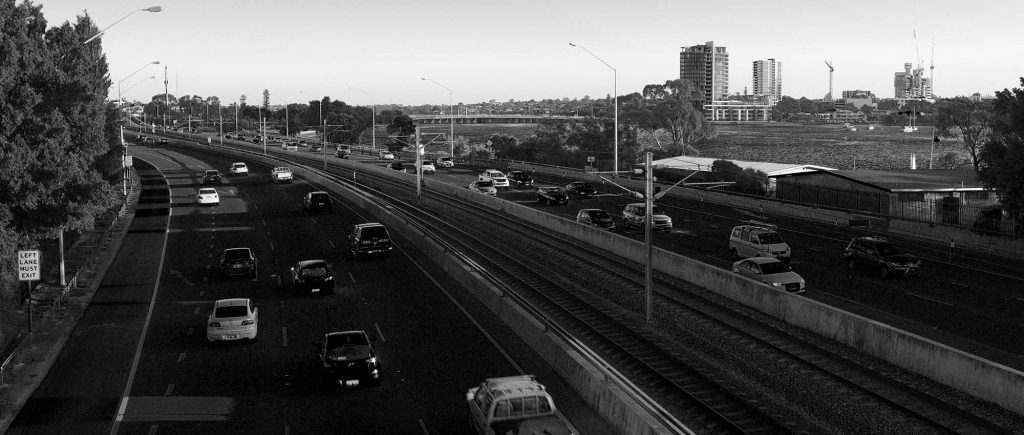


Do I have any primary source for life in Western Australia in the 1870’s-1880’s more infuriating than the work of Mr Jesse Elijah Hammond (1856-1940)?(Probably, yes— but one should never let the truth get in the way of a good rant…)
He was on the ground when it all dramatically happened for the Dyson family. He even lived next door to the Sons of Australia Benefit Society Club house on Murray Street, so it is inconceivable he was not personally acquainted with them even if he did not count them as as friends.
Their mentions in the text of his 1936 memoir “Western Pioneers: The Battle Well Fought” (the most pompous book title in all of history)? nil.
Only the map that he drew from memory of central Perth for the year 1870 did the name “Dyson” appear. It’s fair enough that that it was not Joseph Dyson’s bakery on the corner of Murray and William Street as it was not established until 1873 and that site is listed under it’s owner’s name: Williams. But on the south and east side of Murray and King streets, where the general dealership and family compound of James Dyson and family had been long established, was a strange label: “Dyson’s Hotel”.
Here is where the land use records provide no help at all. Here is what’s listed in the official record:—
Early Owners of Perth Town Lot G14 (and later part of G15):
| 9 June 1840 | Granted to Charles Brown (pays £3 2s.) |
| from 1842 | Purchased by person(s) unknown, (finally owned by someone called John) |
| 1848 | Purchased by James Dyson (pays £12) |
| 6 April 1874 | Mortgaged to the Western Australian Bank for £500 |
| 19 August 1878 | Purchased by George Shenton |
| 24 August 1878 | Purchased by John Joseph Elsegood |
The only other mention of Dyson’s Hotel is in the map published in Stannage’s “The People of Perth” (1979), but that is just a re-drawing of Hammond’s map.
The only explanation I can give is part of a much larger story I have not got my head around yet. Joseph Dyson, James’s eldest son had quite a few traits not shared by the rest of his clan. For the first he was highly religious (atheists tend not to be called to teach at Methodist Sunday schools), secondly he was interested in the temperance movement (for those who know their Dyson history, no sniggering please).
In July 1877, two months after the original Dyson’s Corner was advertised for sale, he was elected to the committee of the City Temperance League. The League was stacked with fellow members of the Methodist church and chaired by their pastor, the Reverend Lowe. At that precise moment the League was trying to arbitrate a dispute between two other alcohol-hating quasi-religious organisations, the Rechabites and the Good Templars.
In March 1878, the (as yet) unidentified promoters of a “Temperance Hotel” published a prospectus. (A Temperance Hotel would serve beverages that were not alcoholic.) The proposed site of this establishment was to be here:—
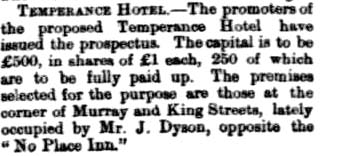
Five hundred Pounds… now where have I heard that sum before? Oh yes, the amount of the mortgage that James Dyson and his wife took out on the property back in 1874… what a coincidence! About this same time, George Towton came into his inheritance and took over the lease of the No Place Inn. (I’m sure he was also thrilled by this plan.)

…someone plaintively asked about the time George Shenton (junior), M.L.C., Merchant, acquired the property in August. The amount he paid for it is not recorded on the deed, but it does say that there were no “encumberances” on the property. ie: The mortgage was gone. He also bought Dyson’s Swamp, which was henceforth to be known (up to the end of the the 20th century) as “Shenton Lake”. He was also an extremely pious benefactor of the Wesleyan Church in Perth (as had been his late father) But I’m not sure this was a factor in his dealings on this occasion, for less than a week after his name had been affixed to the title deed, he had sold the property to John Joseph Elsegood, a Perth builder.
A year later, after extensive renovations, Elsegood applied for a hotellier’s licence for his property on King and Murray street, to be known as the “City Hotel”. His application was opposed (predictably, I suppose) by the rival establishment across the street, The No Place Inn. However, when the pastors representing the temperance movement swanned out of the court after successfully thwarting the application of the first petitioner of the day, Elsegood got his licence, although one of the judges commented:
Mr. Loftie—after consulting with the other two magistrates—said the majority were in favor of granting the application, and that therefore a certificate would issue to the applicant. Personally he might say he was opposed to it, and for this reason—while admitting the necessity for increased hotel accommodation (by which he meant board and lodging accommodation) he thought such might be provided without at the same time increasing the facilities already afforded—and which were ample—for the sale of intoxicating drinks.”
The Western Australian Times (Perth, WA : 1874 – 1879) Fri 7 Mar 1879 Page 2
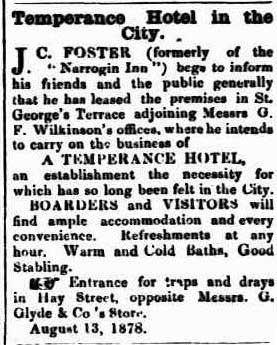
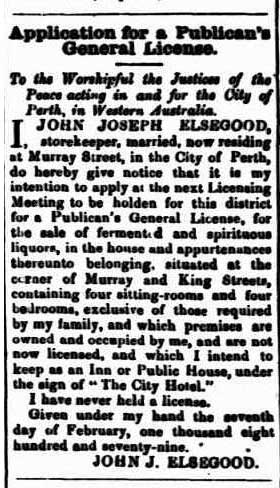
Not only was the idea of a Temperance Hotel dead (at this location), the temperance movement, and in particular the voluble Reverend Traylen, had dropped the ball in blocking the establishment of another legal boosery in town. Traylen had blocked the application and closed an established pub on Barrack Street, the “Commercial Hotel”, on a legal technically (It escaped the attention of precisely no-one that this anti-drink campaigner also owned a property next to the Commercial). That he failed to oppose Elsegood was also noted.
Traylen was furious and responded:
Had I supposed that my leaving the court would be construed into tacit approval of Mr. Elsegood’s application I should have sat to the “bitter end.” If your readers think that consistency demands that I should oppose every applicant, all I can say is, that, circumstances permitting, every new speculator must consider the gauntlet before him.”
The Western Australian Times (Perth, WA : 1874 – 1879) Fri 7 Mar 1879 Page 2
Traylen’s credibility would have been higher if what would have been commonly known back then was as completely forgotten as it is today…
…. Joseph Dyson, son of the former owner of “The City Hotel” land and present active member of the City Temperance League also happened to be John Joseph Elsegood’s brother-in-law.
So Dyson’s Hotel?… I’m just saying.
The City Hotel remained in the Elsegood Family’s hands until the end of the nineteenth century. The site was completely rebuilt in the early twentieth, and this building, now rebranded “The Belgian Beer Cafe” is what exists on the site of the old Dyson’s Corner today.
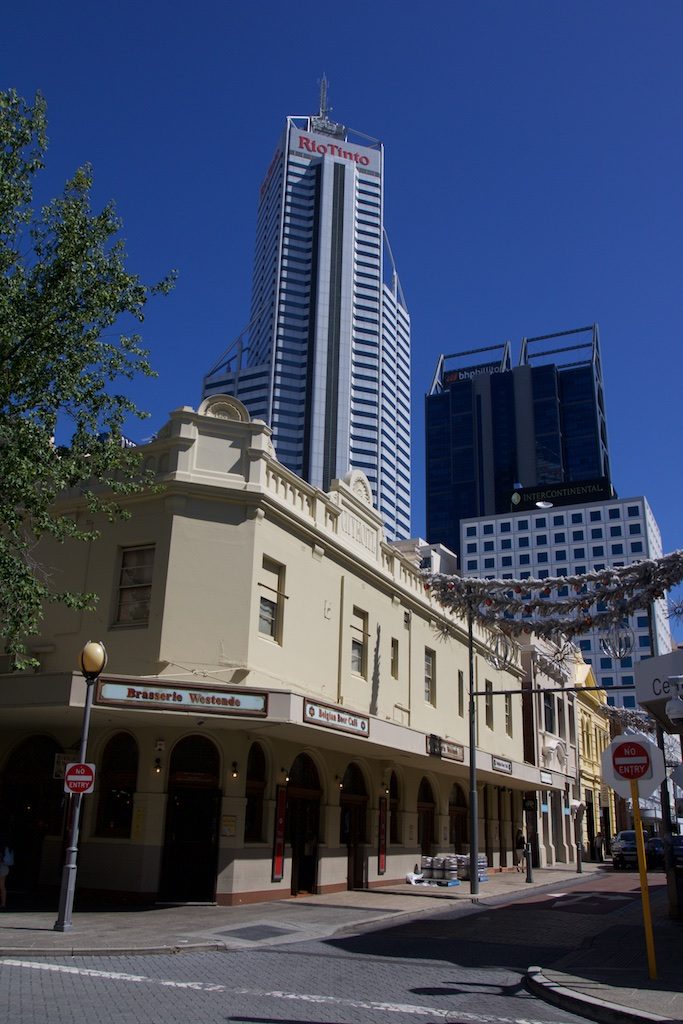
But the Dyson connection with Murray Street was far from over.

As a would-be historian, I am always torn between my desire to share the information I have collected and the desire to find that one final piece of the puzzle that will complete the story I want to tell. Most of the time, that final piece is not— and may never be— there, but what to do then? Should I hoard away what I have so far, or publish and be damned?
If this is not your first reading of this page and what you are reading is different to what you recall, it means I have found some new evidence and re-written accordingly. It is why I chose a weblog to write up my material in the first place.
If the original Dyson family in Western Australia was associated with any one place in Western Australia (other than the eponymous swamp in present-day Shenton Park) it was with Dyson’s Corner, in the town of Perth. One slight problem: there were two Dyson’s Corners, and the only element they possessed in common (apart from the residency of a family called Dyson) was that they were both located (but on different street-corners) in Murray Street, on the unfashionable northern side of the town.
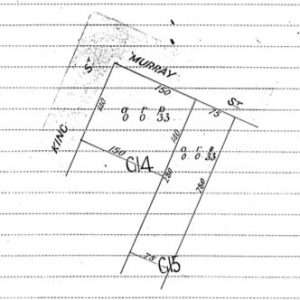
The first Dyson’s Corner was a parcel of land on the south side of Murray Street and the east of King street.
James Dyson, sawyer and timber merchant, finally came into formal ownership of the land on 24 January 1848, but he might have been in occupation much earlier than this, as a renter, possibly since his arrival in the colony back in 1841.
The first European “owner” of this land was a mysterious figure called Charles Brown. He was allocated these blocks in 1840, but only the following year he announced he was planning to leave the colony. As I can find nothing further about him (other than that he was possibly a member of the Methodist congregation, was known for his fruit trees, and owned other parcels of land in the city) I assume he left some time after that.
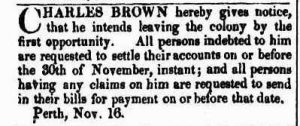
James Dyson paid the sum of £12 for the property in 1848. His neighbours were William Ward, a brick-maker, (and foundation member of the Sons of Australia Benefit Society) also John Chipper, the town bailiff. The deed of transfer was witnessed by the colonial chaplain, the Rev. F. B. Wittenoom, who was also Justice of the Peace. But who did he buy the property from? There in lies the question.
Tracing early title deeds in Western Australia is difficult and expensive. Far be it for me to begrudge a professional historian being paid a very large sum of money to look up a private database for five minutes, but the resultant digital copies you receive, also at great cost for each document you request, were obviously made years ago on very sub-standard equipment. Here is the name of the person Dyson bought the “corner” from as it appears in my document:
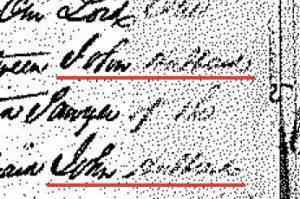
John ? was a sawyer, as was Dyson. Were they business partners? When did John ? buy the property, was it from good ole Charlie Brown? Is that surname Stafford, Hollands, Hutton, or something else entirely?
Its not Stanton, which is a shame, as John Stanton (1797-1877), an early councillor on the Perth town trust, a prominent papist, retired soldier, policeman and barrel-maker would have a documented altercation with Dyson in a couple of years time.

It would be nice to know exactly what the argument was about. Stanton grazed cattle within the Perth jurisdiction. Dyson provided pasturage and water for the Perth herd on his property at Dyson’s Swamp.
A year before Dyson threatened Stanton, on the night of 2nd August 1852— a Monday evening— Dyson created some sort of disturbance in the street that also ended up in court. A month later, his neighbours right across the road, Stephen Hyde and wife Hannah decided to sell up. If the two events are linked, this was a sad ending to a long association. This couple had been witnesses at Dyson’s marriage ten years before. Maybe they did not approve of how he was treating his first wife now? Just to add a little spice to the mix, in September, Mrs Hyde was convicted and fined for assaulting a Mrs Staunton. Was this Staunton the mis-spelled wife of John? When John Stanton died in 1877, Dyson’s probable business rival Benjamin Mason (whose son had been shot by Dyson’s son) was one of his executors.
Hyde (then a bricklayer) had tried to sell up previously in September 1850 (not long after the first convicts arrived). Changing his mind, he instead applied for the licence to turn his premises into a tavern, which he named “The Vine“. Hyde eventually sold up to a man named Henry Alexander Towton, a former Parkhurst boy (forerunner to the convicts) who had well and truly made good. After the Hyde family had departed for South Australia in early October, Towton re-named the establishment the “No-Place Inn“.

Towton’s son was born there the very same month. George Towton grew to be a famous horse trainer in the colony. He was present when one of Dyson’s own grand-children was killed in a racing accident in 1901. After George Towton died in 1906, Dyson’s son Septimus married his widow, but it was not a successful union.

There are no images of Dyson’s Corner from the time the family were in occupancy. The only known vision of the site is a part of a panorama from the top of the Town Hall dated to approximately 1885. The main house on Dyson’s corner is coloured red. On the other side of the road is the No-Place Inn in orange. A description of the corner from a few years earlier:—
A first class 2-storey House, containing Shop and good Cellerage, Bakehouse and Oven ; also a 4-roomed Cottage, good Stable and Kitchen, and Shed to stable 4 horses ; fine Well of Water and a trellis.”
The Western Australian Times (Perth, WA : 1874-1879) Tuesday 27 March 1877 page 3
The four-roomed cottage had come with some additional land adjacent to Dyson’s corner that was purchased at some stage after 1869.
In 1874 the whole property was mortgaged for the sum of £500 advanced to him by members of the Stone family through the Western Australian Bank. What ever the scheme this money was required for did not pay off, so the Corner and most of his other assets, including Dyson’s Swamp, had to be sold three years later.

By 1883 James Dyson’s second marriage to Mrs Jane Edwards was well and truly over, and he had to move into the residence of his eldest surviving son Joseph, located on the corner of Murray Street and William Street. This was the second Dyson’s Corner. Whether James cast out Jane, or her step-son refused to receive her in his home, or Jane herself desired to be rid of the lot of them is not clear, but she went to work for John Liddelow, a general dealer and butcher as a housekeeper in his premises just a bit further down the road on the corner of Murray Street and Barrack Street. Liddelow was a social acquaintance, if not a friend, of her former husband, and might have thought he was doing someone a favour giving her a job. It would be a decision he would regret.
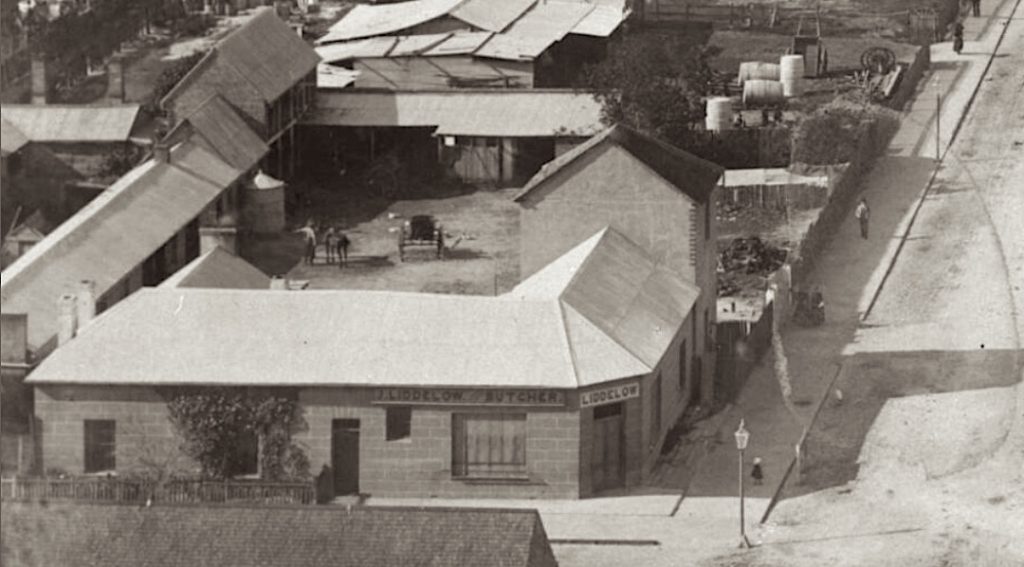
The original Dyson’s Corner on the corner of Murray and King Street, post-Dyson ownership — continued a strange intersection with its former occupier’s fortunes. That will be the subject of part two.

“Poste Restante” is a French term that can be roughly translated as “remainder post“. It refers to when a letter is retained by a post office for collection in that building. Joseph Dyson, junior, ran the Poste Restante department within the central GPO building in Western Australia. Prior to the Federation of the Australian Colonies in 1901, each Colony had its own independent Postal service. These were all rolled together to form what is now known as Australia Post in 1903. The Western Australian service had a fairly grand headquarters on the corner of St Georges Terrace and Barrack street, on the exact site of what had once been the original soldier’s barracks for Perth. The Perth GPO then moved to an even grander structure completed in 1923 and the old building became home to the State Government Treasury Department. What is quite amazing is that both these structures, the Treasury (as it is now known) AND the Commonwealth GPO both still exist in 2017, and both have been sympathetically restored.
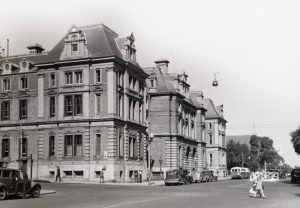
Back in 1901, the building had then only recently been completed, but with a decade, it would be deemed too small. In five years Joseph Dyson had risen through the ranks from letter carrier to head of the department. The workings of the Poste Restante were fully described in a rare article by a journalist who had conducted a full tour of the establishment. The complete article, archived on Trove, is reproduced below:
The recent alterations to the Post-office, together with the new arrangement for receiving letters at that institution, have been fully described in “The Morning Herald,” and a brief reference made to the working of the various branches of this great and important department. In order to gain an idea of the working of the sub-branches, a representative of ‘The Morning Herald’ called at the Post-office yesterday, and, accompanied by an officer of the department, went through the poste restante and the letter carriers’ divisions.
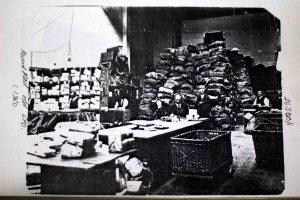
Nobody could form an idea of the amount of work which this branch of the General Post-office carries out daily. Something like 21,200 letters, besides newspaper packets and registered documents, are dealt with weekly by the staff. The offices occupied by the staff are situated on the eastern side of the Post-office hall, where letters addressed to the General Post-office are delivered as called for. The sorting of letters for private boxes and for the various Government departments to be called for entails much labor, and calls for alacrity on the part of the officials. There are 250 private boxes in use, from which the department obtains an annual rental of from one to three guineas each, according to the size of the box, which must be regulated according to the extent of the correspondence for the various firms. The advantages gained by business people through the introduction of private boxes cannot be over-estimated. The letters are placed in the private boxes, and may be extracted by the addressees perhaps hours before they would be delivered to them per the medium of the letter carriers. Besides this, there is an other distinct advantage to the box holders, as they are able to obtain letters at any time between 7 o’clock in the morning and 10 o’clock at night. The letters are immediately sorted into the boxes on the arrival of all mails, and it is therefore surprising to find that out of the 378 boxes in position only 250 are in use. The delivery windows, which are open from 9 a.m.. to 6 p.m., provide, plenty of work for a large number of the staff. In the boom time, before people from the other States had established homes in and around Perth, the number of letters delivered daily was so large that six men were constantly engaged sorting and handing out letters from the delivery windows. The number of letters passing through the Post-office has largely increased since that time, but now that the people are settled, and have fixed residences, the majority of the letters, packets, and newspapers are delivered by the carriers. But even, now the work of delivering letters addressed to the G.P.O., Perth is no sinecure.
There are three delivery offices, the first being for letters from A to G, the second from H to M, and the third from N to Z, besides an additional box for taxed letters, and communications addressed to foreigners. At each of the first three boxes the principal work is that of sorting the epistles alphabetically into 108 pigeon-holes, so that they can be delivered when called for without the delay that would be experienced if all the communications addressed to people whose surnames commenced with, say, B were placed in one pigeon-hole. As it is now, persons can be informed in a few seconds whether there are any letters addressed to them, and if there are registered parcels they are given a ticket and sent to the registered letters’ office. Then there are many additional duties to be performed. One that occupies considerable time is that of re-addressing letters sent care of G.P.O. to private residences, in accordance with instructions sent in by the addressees. After being redirected these letters are despatched to the letter-carriers’ room, where they are sent out with the greatest possible speed. When an eastern mail arrives, the officers are often kept busy until 10 or 11 o’clock in the night— for which no allowance beyond the usual departmental leave of absence on full pay is made— the rule being that all mails must be sorted straight away, so that lessees of private boxes shall receive their correspondence without any delay whatever. For the work performed the staff is not a large one, although it has been increased numerically during the past few weeks by an innovation which has been resented, to a certain extent, by many officers of the service.
Hitherto the work of delivering the letters at the G.P.O. was carried out by male officers ; now women carry out the duties. The alteration was brought about in this way. The increased business throughout the General Post-office necessitated the engagement of further hands, and with a view to economy women were engaged to deliver letters at the boxes, their predecessors being removed to other branches of the department. The women are not overworked— and certainly not overpaid — for their time does not average more than five hours per day. The work is tedious, but with five hour “shifts” the strain imposed on them is not great, and they appear to be contented with their yearly salary. The work was previously carried out by half the number of male officers, but as each of the women employed receives a salary of only 60 guineas per annum, the department is gaining a slight saving by the new arrangement.
The branch is under the control of Mr. Joseph Dyson, and is in every respect up-to-date. In addition to the staff of women, two private-box sorters and two assistants are constantly employed. The introduction of female officers was not at first regarded favorably by the male employes, but it is believed that the system is now working satisfactorily.
The Inquirer & Commercial News (Perth, WA : 1855 – 1901) Friday 28 June 1901 p 12
During the Second World War the basement of the Commonwealth GPO building in Perth was converted into an air raid shelter, and the vast majority of the old Colonial Postal records that were stored there went into whatever the 1940’s version of the skip was. Within the records of the State Library of WA however, are a handful of group photographs of the staff of the during the early days.
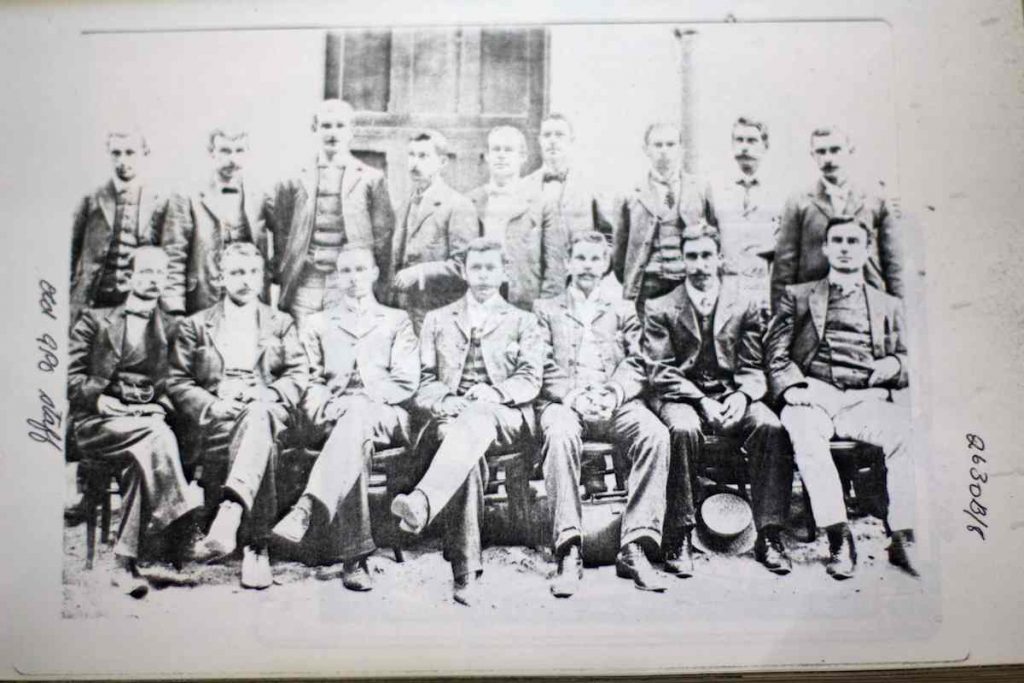
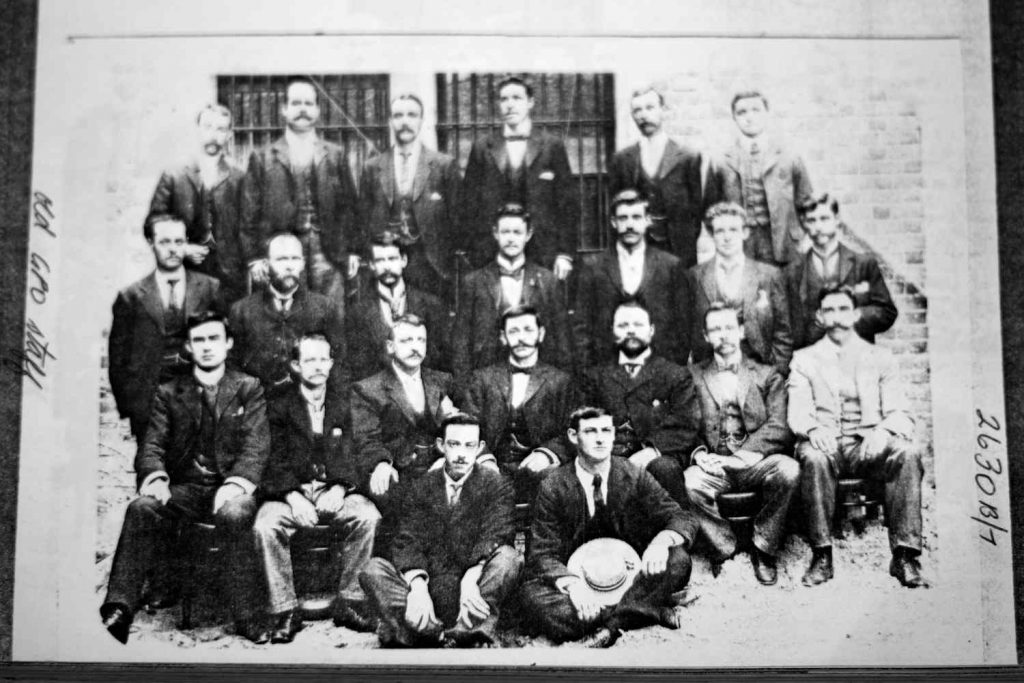
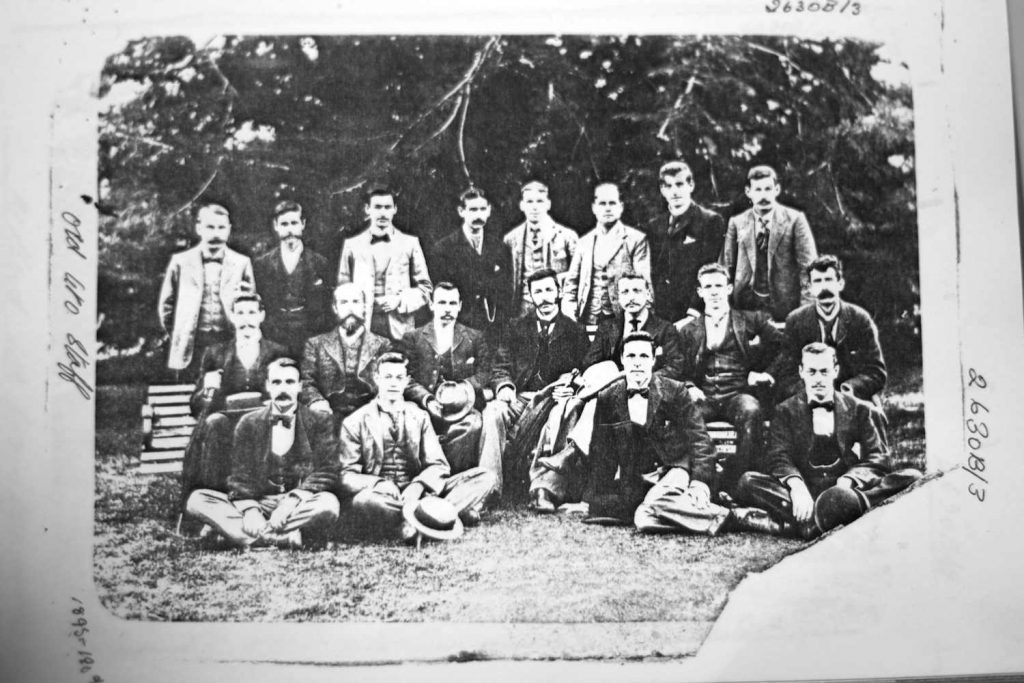
It may be that Joseph Dyson is in these photographs and I just don’t know it. This final image was taken on the steps of the new Federal GPO in Wellington Street. It must date from the 1920’s. Note the presence of ladies…:
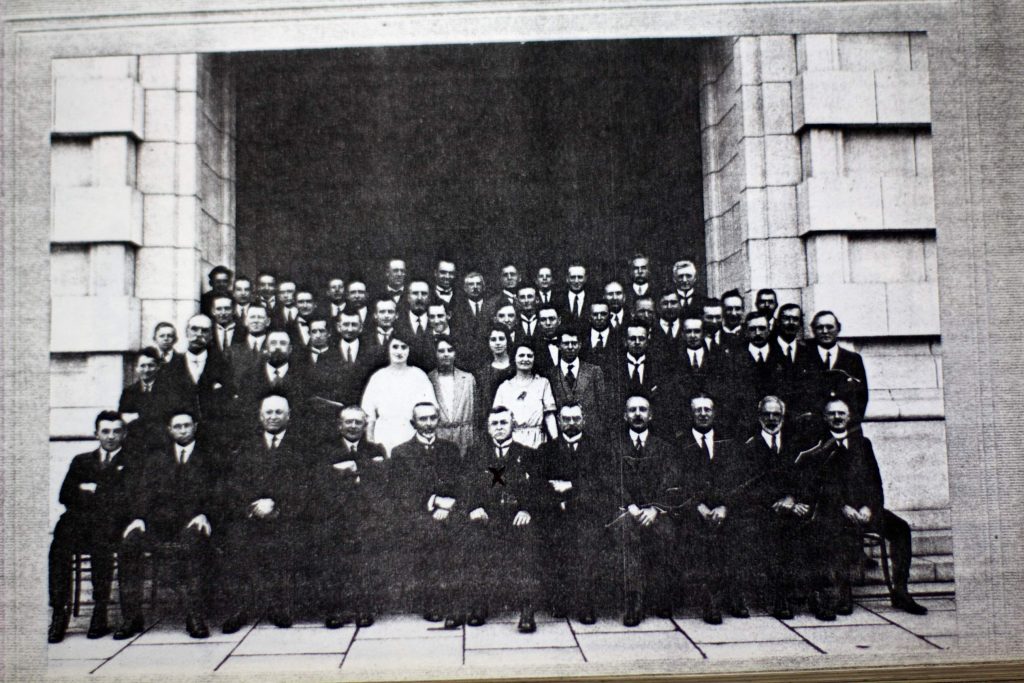
In 2012:
